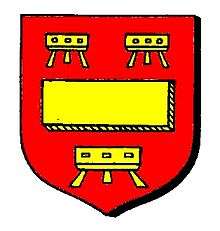Andrew Stratford
Andrew Stratford (died 30 November 1378), also known as Andrew de Stratford and Andrew de Strelford, was a medieval English landowner and verderer of the House of Stratford.[3]
Personal life and family
Andrew was born into the House of Stratford around the beginning of the fourteenth century, a relation of Archbishop of Canterbury John de Stratford and his brother Robert Stratford (Bishop of Chichester).[4] He was an associate of William of Wykeham, Bishop of Winchester and Chancellor of England.[5] He married a women called Christine, and they had a son (Robert) and through him at least two grandchildren (John and Joan).[6] When Robert died prematurely, some time before 1392, Joan was sent to Romsey Abbey, becoming a nun on 19 September 1400,[7] and his Grandson John became a ward of the king, later inheriting his grandfather's lands. His descendants continued into the modern day, and can still be found in parts of Hampshire.[8]
Career
Church Clerk
Prior to 1362 he was rector of the church of Gosberton, Lincolnshire, but exchanged it with Phillip de weston for the prebendary of Langtoft, which he held from 1362-1363.[9] Throughout his life he held numerous church offices (at lay clerk level), including Canon of York, though he never progressed to the clergy;[10] it is likely Stratford's comfortable career as a clerk in the church was aided by his influential ecclesiastical relatives (John, Robert and Ralph), and his friendship with the powerful William of Wykeham.[11]
Verderer and landowner
In later life he became a significant landowner in Hampshire and Wiltshire, as well as an active member of the communities, often loaning money to local businessmen and legally witnessing matters relating to land and property.[12][13] He held (with his wife) land called ‘Haresmede’ in the northern part of South Baddesley (then called simply Baddesley) in the New Forest (referred to confusingly as "North Baddesley in the New Forest," but distinct from the separate village of North Baddesley, which is not in the New Forest),[14][15] and acted as Verderer in the forest of "Claryndon" in Wiltshire until his death.[16] He also held land in Vernhams Dean in the county of Hampshire, alongside land in Chute, Whelpley, Cowesfield, Alderstone and Winterbourne, in the county of Wiltshire.[17][18] These passed on to his son Robert and, when he came of age, to his grandson John.[19]
Death
Stratford died on 30 November 1378, his widow Christine dying 31 July 1396.[20][21] Their son Robert died around the late 1380s, at which time his grandson John became ward of the king, and his granddaughter Joan was sent to Romsey Abbey, where she became a nun in 1399.[22]
Notes
- Guillim, John. "A Display of Heraldry" 1724
- Bedford, WK Riland. "The Blazon of Episcopacy" 1858
- Walter Jenkinson Kaye, "A brief history of the church and parish of Gosberton, in the county of Lincoln" p.47
- Francis Blomefield, 'Hundred of Earsham: Pulham', in An Essay Towards A Topographical History of the County of Norfolk: Volume 5 (London, 1806), pp. 387-405, accessed 11 February 2016.
- Blomefield and Parkin An essay towards a topographical history of the county of Norfolk pp. 390
- Andrew Stratford Archived 23 July 2015 at the Wayback Machine, CIPM 19 - Part VI. Institute of Historical Research
- Liveing, Henry George Downing Records of Romsey Abbey, 1912, p. 166
- "C 139/20/36" The National Archives Record Office Catalogue
- 'Prebendaries: Langtoft', Fasti Ecclesiae Anglicanae 1300-1541: volume 6: Northern province (York, Carlisle and Durham) (1963), pp. 61-63. URL: http://www.british-history.ac.uk/report.aspx?compid=32535 Date accessed: 28 May 2014.
- Walter Jenkinson Kaye, "A brief history of the church and parish of Gosberton, in the county of Lincoln" p.47
- Mackenzie E. C. Walcott "William of Wykeham, His Colleges" p. 10
- "C 241/182/56" The National Archives Records Office Catalogue
- "Calendar of the Close Rolls Preserved in the Pulic Record Ofice". p. 208. Archived from the original on 29 May 2014. Retrieved 28 May 2014.
- Calendar of Inquisitions Post Mortem 19 - Part VI, 678-682: Writ 28 Feb. 1410. Archived 23 July 2015 at the Wayback Machine
- Calendar of Inquisitions Post Mortem 22 - 516: Writ melius inquirendo. 1 February 1425.
- Close Rolls, Richard II: October 1379 - Oct. 26. Westminster. p.268-272
- Calendar of Inquisitions Post Mortem 22 - 517-518:Writ melius inquirendo. 1 February 1425.
- Inquisitions Post Mortem
- "57M76/E/T13" 76057 - Barton Stacey, Odiham etc medieval deeds (photocopies)
- "C 137/76/8" The National Archives Record Office Catalogue
- Houses of Benedictine nuns: Abbey of Romsey History of the County of Hampshire Vol. 2, Victoria County History. pp. 126-132
